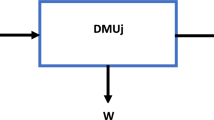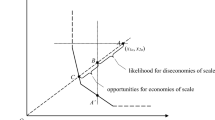Abstract
Efficiency measurement is a key and strategic factor in improving an organization’s performance and increasing their competitive advantage. Nevertheless, measuring efficiency in settings with multicomponent production technologies is a major issue with the existing approaches in the literature. The main contribution of the current paper is to develop a novel nonparametric approach to evaluate efficiency and obviate some of the theoretical barriers in multi-output settings. To this end, for the first time, new technologies assuming multiple hybrid returns-to-scale (MHRTS) with output-specific inputs, joint inputs, and outputs are developed. The new technologies are based on some of the axiomatic principles in data envelopment analysis (DEA) for forming a new production possibility set (PPS) to measure the efficiency of decision-making units (DMUs). By implementing the MHRTS technologies with output-specific inputs, joint inputs, and outputs, the proposed models can deal with undesirable outputs. Compared with the existing technologies in the DEA literature, the new technologies not only can incorporate output-specific inputs, joint inputs, and outputs for the performance evaluation of DMUs but also obviate existing theoretical barriers in the MHRTS technology. The applicability and usefulness of the proposed method are validated using a case study in the energy sector.



Similar content being viewed by others
Notes
Note that, as requested by the organization, we have removed the names of the power plants in the tables and figure.
References
An Q, Wang P, Yang H, Wang Z (2021) Fixed cost allocation in two-stage system using DEA from a noncooperative view. Or Spectrum 43(4):1077–1102
Anouze ALM, Bou-Hamad I (2019) Data envelopment analysis and data mining to efficiency estimation and evaluation. Int J Islam Middle East Financ Manag 12(2):169–190
Ayouba K, Boussemart J-P, Lefer H-B, Leleu H, Parvulescu R (2019) A measure of price advantage and its decomposition into output-and input-specific effects. Eur J Oper Res 276(2):688–698
Azadi M, Emrouznejad A, Ramezani F, Hussain FK (2022) Efficiency measurement of cloud service providers using network data envelopment analysis. IEEE Transactions on Cloud Computing 10(1):348–355
Banker RD, Charnes A, Cooper WW (1984) Some models for estimating technical and scale inefficiencies in data envelopment analysis. Manage Sci 30(9):1078–1092
Beasley JE (1995) Determining teaching and research efficiencies. J Ovof Op Res Soc 46(4):441–452
Bernardo M, de Souza MAM, Lopes RSM, Rodrigues LF (2020) University library performance management: Applying zero-sum gains DEA models to resource allocation. Socio-Economic Planning Sciences 1:100808
Bititci US, Garengo P, Ates A, Nudurupati SS (2015) Value of maturity models in performance measurement. Int J Prod Res 53(10):3062–3085
Bourne M, Franco-Santos M, Micheli P, Pavlov A (2018) Performance measurement and management: a system of systems perspective. Int J Prod Res 56(8):2788–2799
Chan SH, Song Q, Sarker S, Plumlee RD (2017) Decision support system (DSS) use and decision performance: DSS motivation and its antecedents. Inform Manag 54(7):934–947
Charnes A, Cooper WW, Rhodes E (1978) Measuring the efficiency of decision making units. Eur J Oper Res 2(6):429–444
Chen M, Ang S, Jiang L, Yang F (2020) Centralized resource allocation based on cross-evaluation considering organizational objective and individual preferences. Or Spectrum 42(2):529–565
Chenhall RH (2005) Integrative strategic performance measurement systems, strategic alignment of manufacturing, learning and strategic outcomes: an exploratory study. Acc Organ Soc 30(5):395–422
Cherchye L, De Rock B, Dierynck B, Roodhooft F, Sabbe J (2013) Opening the “black box” of efficiency measurement: Input allocation in multioutput settings. Oper Res 61(5):1148–1165
Cherchye L, De Rock B, Walheer B (2015) Multi-output efficiency with good and bad outputs. Eur J Oper Res 240(3):872–881
Cherchye L, De Rock B, Walheer B (2016) Multi-output profit efficiency and directional distance functions. Omega 61:100–109
Cherchye L, De Rock B, Hennebel V (2017) Coordination efficiency in multi-output settings: a DEA approach. Ann Oper Res 250(1):205–233
Cook WD, Green RH (2004) Multicomponent efficiency measurement and core business identification in multiplant firms: A DEA model. Eur J Oper Res 157(3):540–551
Cook WD, Hababou M (2001) Sales performance measurement in bank branches. Omega 29(4):299–307
Cook WD, Zhu J (2006) Incorporating multiprocess performance standards into the DEA framework. Oper Res 54(4):656–665
Cook WD, Zhu J (2011) Multiple variable proportionality in data envelopment analysis. Oper Res 59(4):1024–1032
Cook WD, Hababou M, Tuenter HJ (2000) Multicomponent efficiency measurement and shared inputs in data envelopment analysis: an application to sales and service performance in bank branches. J Prod Anal 14(3):209–224
Cooper W. 2007, Seiford LM, Tone K (2000). Data envelopment analysis: a comprehensive text with models, applications, references and DEA-solver software, Boston: Kluwer Academic Publishers
Dellnitz A, Reucher E, Kleine A (2021) Efficiency evaluation in data envelopment analysis using strong defining hyperplanes. Or Spectrum 43(2):441–465
Ding J, Feng C, Bi G, Liang L, Khan MR (2015) Cone ratio models with shared resources and nontransparent allocation parameters in network DEA. J Prod Anal 44(2):137–155
Färe R, Grosskopf S, Noh D-W, Weber W (2005) Characteristics of a polluting technology: theory and practice. Journal of Econometrics 126(2):469–492
Franco-Santos M, Lucianetti L, Bourne M (2012) Contemporary performance measurement systems: A review of their consequences and a framework for research. Manag Account Res 23(2):79–119
Goto M, Tsutsui M (1998) Comparison of productive and cost efficiencies among Japanese and US electric utilities. Omega 26(2):177–194
Grafton J, Lillis AM, Widener SK (2010) The role of performance measurement and evaluation in building organizational capabilities and performance. Acc Organ Soc 35(7):689–706
Hailu A, Veeman T (2001) Non-parametric productivity analysis with undesirable outputs: an application to Canadian pulp and paper industry. Am J Agr Econ 83(3):605–616
Henri J-F (2006) Management control systems and strategy: A resource-based perspective. Acc Organ Soc 31(6):529–558
Imanirad R, Cook WD, Zhu J (2013) Partial input to output impacts in DEA: Production considerations and resource sharing among business subunits. Naval Res Logistics (nrl) 60(3):190–207
Khalili-Damghani K, Tavana M, Haji-Saami E (2015) A data envelopment analysis model with interval data and undesirable output for combined cycle power plant performance assessment. Expert Syst Appl 42(2):760–773
Khanjarpanah H, Jabbarzadeh A (2019) Sustainable wind plant location optimization using fuzzy cross-efficiency data envelopment analysis. Energy 170:1004–1018
Korhonen PJ, Luptacik M (2004) Eco-efficiency analysis of power plants: An extension of data envelopment analysis. Eur J Oper Res 154(2):437–446
Kuosmanen T, Poidinovski V (2009) Weak disposability in nonparametric productivity analysis with undesirable outputs: Reply to Färe and Grosskopf. Am J Agr Econ 87(4):1077–1082
Liang Y-H (2015) Performance measurement of interorganizational information systems in the supply chain. Int J Prod Res 53(18):5484–5499
Maestrini V, Luzzini D, Maccarrone P, Caniato F (2017) Supply chain performance measurement systems: A systematic review and research agenda. Int J Prod Econ 183:299–315
Mahmoudi R, Emrouznejad A, Khosroshahi H, Khashei M, Rajabi P (2019) Performance evaluation of thermal power plants considering CO2 emission: a multistage PCA, clustering, game theory and data envelopment analysis. J Clean Prod 223:641–650
Manville G, Greatbanks R (2020) Performance management in hybrid organisations: a study in social housing. Eur Manag J 38(3):533–545
Mardani A, Zavadskas EK, Streimikiene D, Jusoh A, Khoshnoudi M (2017) A comprehensive review of data envelopment analysis (DEA) approach in energy efficiency. Renew Sustain Energy Rev 70:1298–1322
Matin RK, Amin GR, Emrouznejad A (2014) A modified semi-oriented radial measure for target setting with negative data. Measurement 54:152–158
Micheli P, Mari L (2014) The theory and practice of performance measurement. Manag Account Res 25(2):147–156
Micheli P, Mura M (2017) Executing strategy through comprehensive performance measurement systems. Int J Oper Prod Manag 37(4):423–443
Podinovski VV, Ismail I, Bouzdine-Chameeva T, Zhang W (2014) Combining the assumptions of variable and constant returns to scale in the efficiency evaluation of secondary schools. Eur J Oper Res 239(2):504–513
Podinovski VV, Olesen OB, Sarrico CS (2018) Nonparametric production technologies with multiple component processes. Oper Res 66(1):282–300
Rezaee MJ, Moini A, Makui A (2012) Operational and non-operational performance evaluation of thermal power plants in Iran: A game theory approach. Energy 38(1):96–103
Roets B, Verschelde M, Christiaens J (2018) Multi-output efficiency and operational safety: An analysis of railway traffic control centre performance. Eur J Oper Res 271(1):224–237
Samavati T, Badiezadeh T, Saen RF (2020) Developing Double Frontier Version of Dynamic Network DEA Model: Assessing Sustainability of Supply Chains. Decis Sci 51(3):804–829
Seiford LM, Zhu J (2002) Modeling undesirable factors in efficiency evaluation. Eur J Oper Res 142(1):16–20
Shephard RW (2015) Theory of cost and production functions. Princeton University Press
Silva MCA (2018) Output-specific inputs in DEA: An application to courts of justice in Portugal. Omega 79:43–53
Sueyoshi T, Goto M (2015) Environmental assessment on coal-fired power plants in US north-east region by DEA non-radial measurement. Energy Economics 50:125–139
Sueyoshi T, Goto M (2016) Undesirable congestion under natural disposability and desirable congestion under managerial disposability in US electric power industry measured by DEA environmental assessment. Energy Economics 55:173–188
Tajbakhsh A, Hassini E (2018) Evaluating sustainability performance in fossil-fuel power plants using a two-stage data envelopment analysis. Energy Economics 74:154–178
Walheer B (2018) Disaggregation of the cost Malmquist productivity index with joint and output-specific inputs. Omega 75:1–12
Walheer B (2020) Output, input, and undesirable output interconnections in data envelopment analysis: convexity and returns-to-scale. Ann Oper Res 284(1):447–467
Wang D, Li S, Sueyoshi T (2014) DEA environmental assessment on US Industrial sectors: investment for improvement in operational and environmental performance to attain corporate sustainability. Energy Economics 45:254–267
Wang CN, Dang TT, Wang JW (2022) A combined data envelopment analysis (DEA) and grey based multiple criteria decision making (G-MCDM) for solar PV power plants site selection: A case study in Vietnam. Energy Rep 8:1124–1142
Yaisawarng S, Klein JD (1994) The effects of sulfur dioxide controls on productivity change in the US electric power industry, The Review of Economics and Statistics, pp 447–460
Zhang Q, Koutmos D, Chen K, Zhu J (2019) Using operational and stock analytics to measure airline performance: a network DEA approach. Decis Sci 51(3):804–829
Zhou D, Wu F, Zhou X, Zhou P (2016) Output-specific energy efficiency assessment: a data envelopment analysis approach. Appl Energy 177:117–126
Acknowledgements
Authors would like to appreciate the constructive comments of four Reviewers.
Author information
Authors and Affiliations
Corresponding author
Additional information
Publisher's Note
Springer Nature remains neutral with regard to jurisdictional claims in published maps and institutional affiliations.
Rights and permissions
About this article
Cite this article
Azadi, M., Karimi, B., Ho, W. et al. Assessing green performance of power plants by multiple hybrid returns to scale technologies. OR Spectrum 44, 1177–1211 (2022). https://doi.org/10.1007/s00291-022-00682-z
Received:
Accepted:
Published:
Issue Date:
DOI: https://doi.org/10.1007/s00291-022-00682-z




